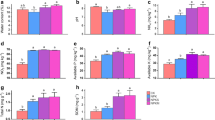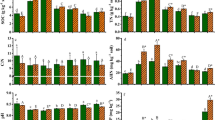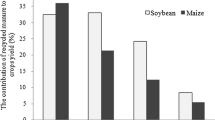Abstract
Recent on-farm liming experiments showed that Mo deficiency in soybean [Glycine max (L.) Merr.] is widespread in northern Alabama. In contrast, a long-term, fertility-rotation experiment in the same area showed no response to Mo during 33 yr when Mo was added bienially to corn [Zea mays L.] in the rotation; however, soybean foliage had the chlorotic appearance of Mo deficiency. The objective of this study was to determine if Mo deficiency was being missed by comparing only two fertilizer treatments. Each rotation-fertilizer treatment plot was split into two, with one-half receiving MO at a 100 g ha−1 foliar rate after seedling emergence, while the other half received none. Yields were increased by Mo in 13 to 16 fertilizer treatments in 1985 and 15 out of 16 in 1986. Leaf-N concentrations and seed weight had comparable increased amounts by the Mo supplement. Without the Mo supplement, there was a response to lime but not to P, K, or a Mo-containing micronutrient mixture; with the Mo supplement, there was no response to liming, but a definite response to P and K (in addition to Mo). The lack of response to Mo when applied to corn in a 2-yr rotation over 33 yr led to the erroneous conclusion that these soils were not Mo deficient for soybean.
Similar content being viewed by others
References
Adams F (1980) Interaction of phosphorus with other elements in soils and in plants.In FE Khasawneh, EC Sample, and EJ Kamprath (ed) The role of phosphorus in agriculture. ASA, CSSA, and SSSA, Madison, Wis
Burmester CH, Adams JF and Odom JW (1988) Response of soybean to lime and molybdenum on Ultisols in northern Alabama. Soil Sci Soc Am J 52: 1391–1394
Cope JT (1984) Long-term fertility experiments on cotton, corn, soybeans, sorghum, and peanuts, 1929–1982. Alabama Agric Exp Stn Bul 561
Mulder EG (1954) Molybdenum in relation to growth of higher plants and micro-organisms. Plant and Soil 4: 368–415
Olsen SR (1972) Micronutrients interactions.In JJ Mortvedt, PM Giodano and WL Lindsay (ed) Micronutrients in Agriculture. Soil Sci Soc Am, Madison, Wis
Author information
Authors and Affiliations
Rights and permissions
About this article
Cite this article
Adams, J.F., Burmester, C.H. & Mitchell, C.C. Long-term fertility treatments and molybdenum availability. Fertilizer Research 21, 167–170 (1990). https://doi.org/10.1007/BF01087427
Received:
Accepted:
Issue Date:
DOI: https://doi.org/10.1007/BF01087427




